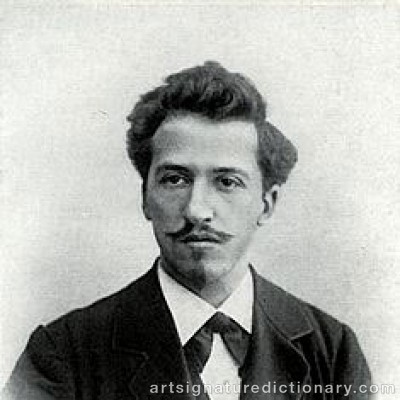
Piet MONDRIAN
1872–1944, Netherlands/USA
Also known as: PM
Biography
Discover the life and artistic journey of Piet, Pieter Cornelis MONDRIAN (born 1872, 7/3, Netherlands, died 1944, 1/2, USA), including key biographical details that provide essential context for signature authentication and artwork verification. Understanding an artist's background, artistic periods, and career timeline is crucial for distinguishing authentic signatures from forgeries.
Piet Mondrian (March 7, 1872 - February 1, 1944) was a Dutch painter and an important contributor of the De Stijl art movement, which was founded by Theo van Doesburg.
Born at Amersfoort in The Netherlands as Pieter Cornelis Mondriaan, he began his career as a teacher in primary education, but while teaching he also practiced painting. Most of his work from this period is naturalistic or impressionistic. On display in the Hague's Gemeentemuseum is a number of paintings from this period, including such post-impressionist works as "The Red Mill" and "Trees in Moonlight". (Examples of his more familiar geometric later work are also on display.)
He was deeply struck by an exhibition of Cubism held in Amsterdam in 1911 which profoundly affected his later work. His search for simplification is shown in two versions of "stilleven met gemberpot" ("still life with ginger pot"). The 1911 versionis cubist, in the 1912 version it is reduced to a round shape with triangles and rectangles. He even simplifies his last name, by dropping an 'a', signing his work as "Mondrian"
His painting "Broadway Boogie-Woogie" at the Museum of Modern Art in New York City is highly influential in the school of abstract geometric painting. The piece is made up of a number of shimmering squares of bright color that leap from the canvas, then appear to shimmer, drawing you into those neon lights.
His most well-known works are the familiar colored squares of three or four parts asymmetrically grouped, segmented blocks of straight lines and primary colors that some believe look as though anyone, even a child, could paint; however, others find his compositions in the style which Mondrian termed neoplasticism to be original and difficult to reproduce to obtain the same effect that Mondrian's work can give to some. His oft-emulated reductionist style continues to inspire artists, fashion and advertising. Although Mondrian was a fine artist (not a commercial artist), he is considered the father of advertising design, because of the widespread and continued adoption of his grid style as a basic structure of graphic design layout.
He died in New York City in 1944, of pneumonia, and was interred in the Cypress Hills Cemetery in Brooklyn, New York.
Source: http://www.oceansbridge.com http://en.wikipedia.org/wiki/Piet_Mondrian
Explore other artists
Discover other notable artists who were contemporaries of Piet MONDRIAN. These artists worked during the same period, offering valuable insights into artistic movements, signature styles, and authentication practices. Exploring related artists makes it easier to recognize common characteristics and artistic conventions of their era.